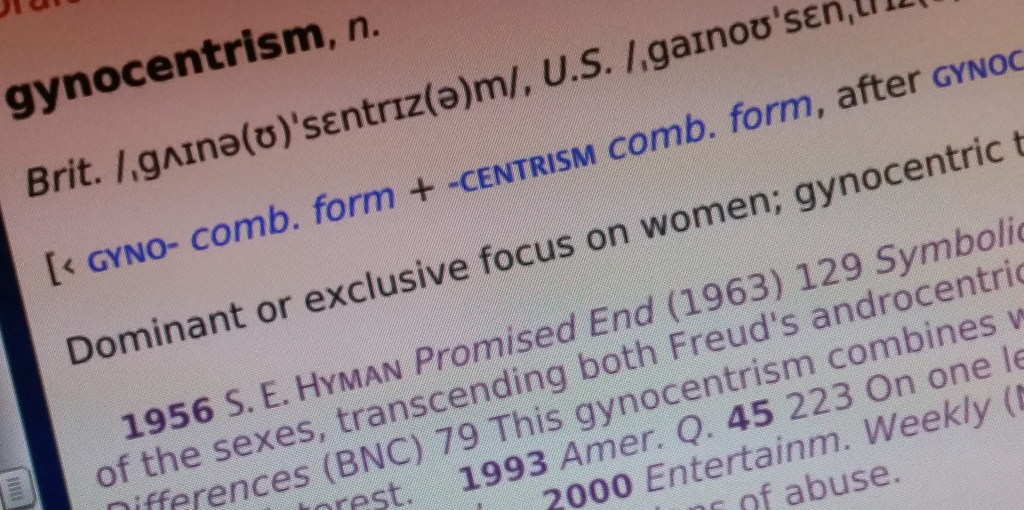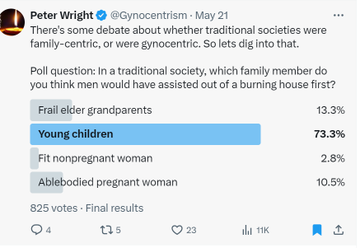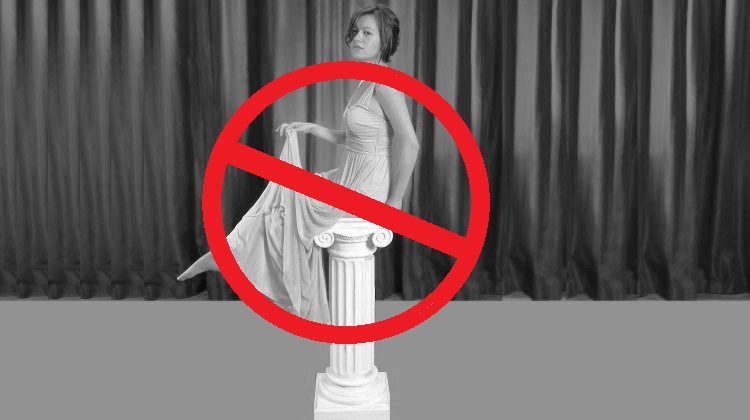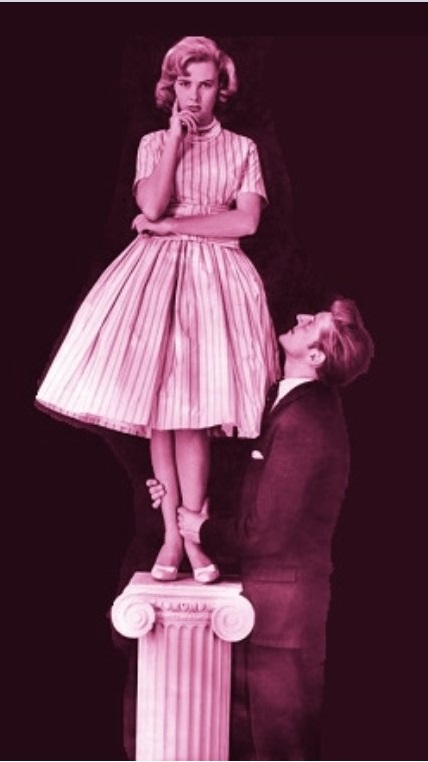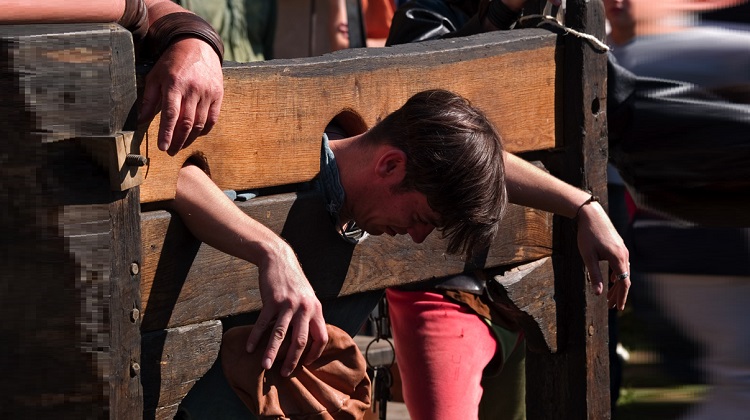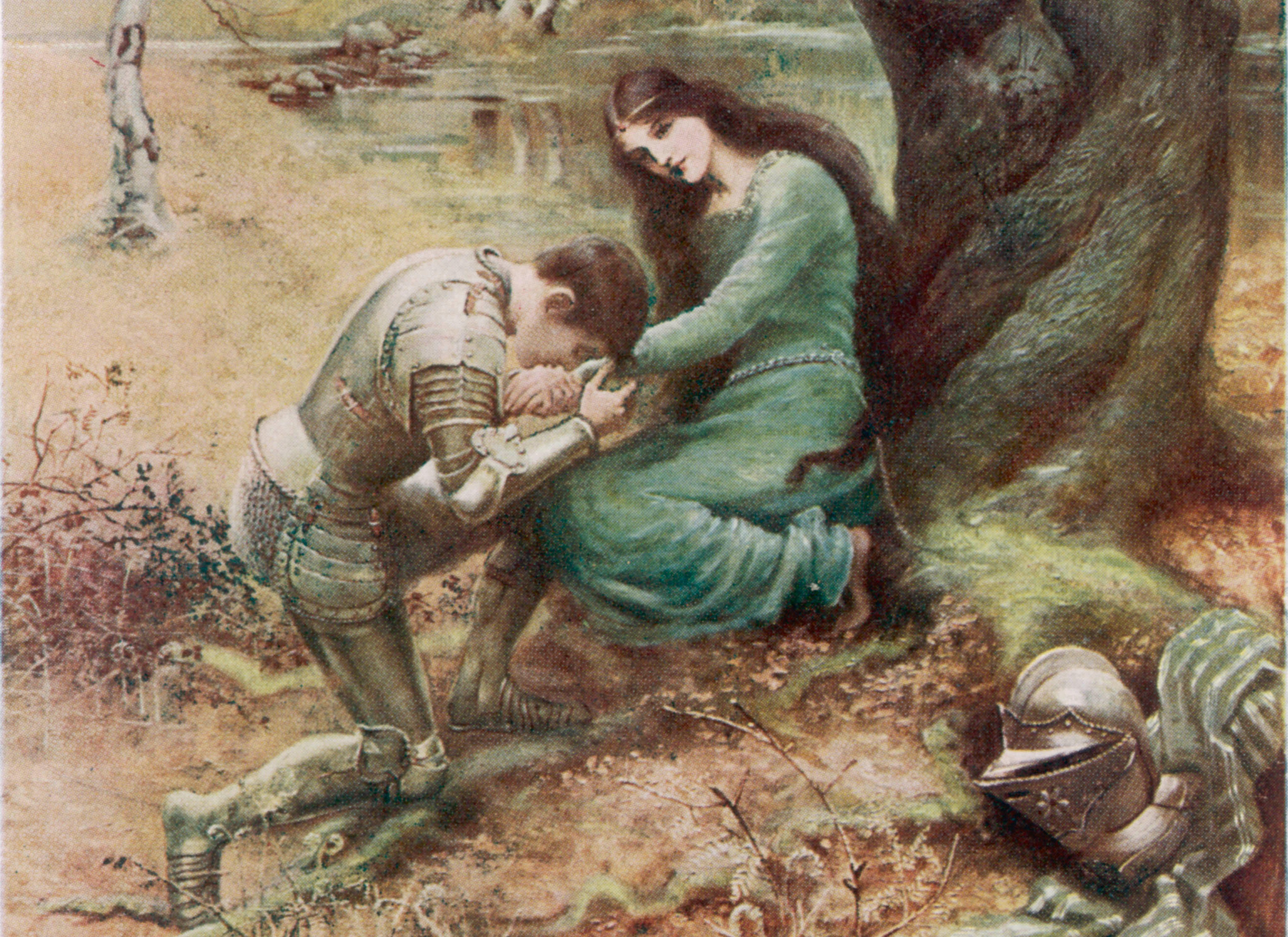
The following excerpts are from Esther Vilar’s profoundly insightful volume The Polygamous Sex (1976). In this little-known work she poses the theory that women mold husbands into a father figures, protectors and providers to whom they play the role of pampered child. Vilar points out that the childish qualities arousing protective instincts in men are the opposite qualities of those that attract sexual arousal, thus leaving men in a peculiar, dissonant position of having an intimate partner who is both burdensome child and sexual partner, an unacceptable pairing which leads ultimately to a deterioration in the relationship. Vilar points out that women work feverishly to establish this relational dynamic, and asks; what does it profit a woman to lose a lover and gain a father? – PW.
____________________________
THE POWER OF THE WEAKER PARTNER
The fact that women are never seen carrying heavy burdens, lifting or pushing weights, helps to advertise their muscle weakness. When they weep easily, at the slightest provocation, their tears remind their onlookers of their weaker nerves. By enveloping themselves in fine fabrics and by means of make-up, they can make themselves look fragile to the point of imminent physical breakdown. It is not so long since this kind of comedy was incomplete without simulated fainting fits.
Women also prefer to be seen in the company of taller, older men; it underlines their simulated vulnerability. It all depends on exaggerating to the limit the existing physical difference between protector and protégé. The wife’s greater physical resilience is her secret; by the time it becomes obvious, her provider is dead. In the USA, for instance, the widow survives her spouse on the average by eleven years.
‘WITH THIS RING I THEE ADOPT!’
Compared with a child of one’s own, which one protects automatically, a woman makes a somewhat inadequate object of one’s protective instinct. When a man takes her on as his charge, he does it not instinctively but consciously, by persuading himself that here is a helpless creature who needs him. Every woman is therefore in competition with every other inadequate (non-instinctual) protégé. Orphans, the sick, the old, the mentally disabled, the poor, young pups and stray cats are basically all much more in need of protection than women. How to distract a man’s attention from all these potential competitors and concentrate it exclusively upon the woman seeking to arouse his latent protective instinct is therefore a major problem.
This is not as hard as it seems at first: most people practice altruistic love for a reward of some kind, as we have said — cash, prestige, companionship, eternal life. Women have a interesting reward to offer for the protection they seek: they are the only kind of inadequate protégé that is in a position to satisfy a man’s other social instinct — his sex drive. From the man’s point of view, this is the prize reward of them all.
But a woman seeking protection primarily can never be an adequate sex partner because she lacks one prerequisite for that: intellectual equality. But since most men hardly ever meet ideal sex partners — feminine women who are nevertheless as intelligent as men — the man really has no choice. If he is not to be empty handed, he has to settle for altruistic love for a pseudo-child, and for rational love instead of sexual love. He compromises on a concoction: part ward, part sex mate, part child, part woman. “She may not be the love of my dreams,” he thinks, “but I can still take her to bed — and besides, she needs me.” To be his child, the woman doesn’t resemble him enough — but she is weaker than he, physically and mentally. To be his ideal sex partner, she is not sufficiently on a par with him intellectually — however, she looks sufficiently different from him to be attractive.
In other words, rather than leave both of his social instincts unsatisfied a man will put up with playing the father to an adult who occasionally lets him have her body for sexual purposes. Since the average man cannot find the woman who will be a true marriage partner at all, he accepts one of many being offered for adoption by her parents, and in a grandiose ceremony vows to take her natural father’s place in providing for her henceforth. If the priest or registrar were to ask him whether he was prepared to “take this woman” as his child, he might not even notice. When the girl in white with the bouquet says “Yes”, the man knows perfectly well that he has adopted her, “for better or for worse”: “the child” will henceforth bear her new father’s name and live on his money.
To keep him from having any ideas about his search for a woman, she also plays the lover from time to time. After the birth of the first child — her ideal protégé, and his as well — the power of “the adopted daughter” is so well established that she runs little risk of losing the adoptive father to a real woman. The role of sex partner, originally used as bait, tends to be neglected at this point. Soon the day will come when only the presence of their children will remind the couple that, once upon a time, they used to sleep together.
THE POWER OF THE COLDER PARTNER
Once a woman has opted for the role of the child (instead of lover) the next step is predetermined. A child must not show too great an interest in sex, on pain of losing credibility and a child’s privileges. A woman who values her status as protégé, therefore, must keep her sex drive under control. She must be in a position to make conscious use of her sexuality for her purposes i.e. to win a man who appears suited to play her father, rather than a man who excites and confuses her senses and her mind. And she must be able to refuse herself to her intended protector until he adopts her or at least commits himself clearly to such an intention. To see primarily the sex partner in a man is the end of her power over him. It means losing the motive of making him her protector — what good is a lover restrained by protective feelings? — and being quite as dependent on him, sexually, as he is on her.
To stay stupid is, as we have said, a piece of cake; it costs no effort at all. To stay cold, on the other hand, requires considerable self-discipline — but women evidently find that it pays, just the same. Not only are men and women born with the same mental endowment, the same instinct of self-preservation and caring for their brood, but they also inherit the same predisposition to an active sex life. But sexual cravings can be conditioned: nuns and priests are good examples of that. Only nuns, being women, typically begin their training much earlier than their male counterparts, which is why we hear of far fewer missteps and scandals among them.
The rest of womankind is under no constraint to practice such total self-control. On the contrary, total frigidity would hamper them and it might lead to extremes such as refusing sex altogether, even as bait for attracting a protector. How easily the conditioning of the sex drive can lead to frigidity is revealed by a recent opinion poll taken among thousands of Italian women of every social class (Doxa, Rome 1974). Queried about their sexual attitudes, 36% of these women between the ages of twenty and fifty expressed a total lack of interest in marital sex; in fact, they said they would prefer giving it up altogether. So high a degree of sexual frigidity is excessive and rather disruptive. What matters is only to be the more frigid of the two partners — because the power is always in the hands of the colder sex partner.
FATHERS ARE POWERLESS
Children don’t love their parents; they are merely attached to them: they need them, and sometimes they even like them. When father and mother have the knack of clothing their instinctive and essentially self-gratifying nurturing of their brood in the image of self-sacrificial devotion, they may enjoy as a fringe benefit the child’s guilt and gratitude, as well. But this is not love, nor should it be: if children returned the love of their parents in full measure, life would come to a standstill, because they would never want to leave home. Children by and large tend to leave their parents at the earliest possible opportunity, to go looking for their own love objects (protégé). Many never return home, or do so only out of a sense of duty.
Children can feel real love for their parents only as they gradually become old and helpless. When physical debility, intellectual inferiority, and resemblance characterize the parent, it becomes possible for the grown son to love his father as a genuine protégé. At this point, however, the father’s love has come to an end. Between protector and protégé there is always only one who loves: always the protector. The protégé accepts whoever will be his provider. If another, better provider comes along, he will be accepted, without any great emotional investment; the most to be expected is a certain loyalty. For what is involved is only the protégé’s instinct of self-preservation, a necessarily asocial instinct. If this were fixated upon a specific individual and that individual perished, so would the protégé.
A man who marries a woman inferior to himself i.e. “adopts” her must expect that she cannot feel anything for him but liking and gratitude. A woman is better off than a child, after all; if necessary, she can take care of herself, like any man. That she nevertheless allows her husband to pay all the bills is a personal concession that can be retracted at any time. She is entitled, therefore, to high expectations: everything done for her must be first-rate, otherwise she may engage another protector or else, depending upon circumstances, even decide to take care of herself. Compared with the real father, a wife’s “adopted father” has no hope of becoming his pseudo-child’s protégé in his old age, either. The most he can hope for is the status of an inadequate or pseudo-protégé i.e. if he is lucky, he may come to enjoy the woman’s altruistic love, her charity.
The woman even gets a reward: she inherits his property, his insurance, his pension rights, so that he can go on providing for her after his death, the death she is statistically prepared to survive for, on the average, six years, plus the number of years she is younger than he is.
Turning to the man’s role for a moment, one might suppose that a protector, armed with material power over his dependent, is in a position to blackmail her. But that is precisely what he can never do. If he were capable of it, he would never have undertaken the charge in the first place. Who really enjoys working for someone else’s benefit? But the nurturing instinct is so powerful a drive that there is no evading its power. Not even women have as yet succeeded in modifying it. But for them it is so much less onerous to satisfy their brood-hatching instincts. Even if the woman is the partner who originally wanted the child — the man already had his child, in the person of his wife — it is always the man who will be responsible for its care and feeding. The nurturing instinct is polyvalent i.e. a man can have more than one “young charge” under his wing.
When the first real “protégé” for both is born, the wife merely advances to the position of eldest daughter. A woman who bears children therefore has a double advantage: she satisfies her own nurturing instinct and simultaneously strengthens the foundations of her own security. As the mother of authentic protégés she must be provided for, even if she ceases to seem quite as helpless and appealing as her role ideally calls for.
The power of the child over his parents — that of the biologically weaker over the stronger — is a law of nature. Without such power, they would starve, being unable to take care of themselves. That parents will dash into a burning house or hurl themselves into a raging flood to save their young is a matter of course. That men go to war for their women is also considered a matter of course. A man who must be a father to his wife is powerless, where she is concerned.
THE ‘WEAKER SEX’ HOLDS ALL THE ACES
The biological power structure rests on two instincts: sex, and caring for the brood. Whoever needs, for the satisfaction of one or both of these instincts, a particular individual, loses his independence to that individual. To love is to become enslaved. Contrariwise, whoever is loved has the lover in his power. Thus, power equals the ability to make oneself the object of another person’s love. Only the human female is in a position, as we have seen, to make herself the object of the male sex drive without becoming equally dependent on the male for instinctual satisfaction. She does not need the man to satisfy her sex drive; she has it under firm control, as bait or weapon in the sexual power struggle. Sex, to the woman, is too valuable, as it were, to be wasted on mere self-indulgence. So if it is a question of one sex dominating the other, it can never be the male who dominates, but the female.
“The first instance of social oppression,” runs a famous statement by Friedrich Engels, patron and coauthor of Karl Marx, “is the oppression of woman by man.” Engels is confusing force with power. Like so many Leftists after him, Engels injected metaphorically a concept of power structures resting on force into the sex war, where it does not apply. Only because a man is physically stronger and able to earn money, Engels believed that this gives the man power over the woman. However physical force may be helpful in oppressing a social class — it is no way to win control over the other sex.
The potential oppressor is never the stronger partner, but always the more helpless one; the potential ruler is never the one driven by desire, but the desired. If it is true that women are physically and mentally the weaker sex, and that they are more desired by men than desirous, then “the first social oppression” is the oppression of men by women, not the other way around. The woman usually begins to suffer long after the man has been miserable for a long time.
Female power is the foundation of all other power structures. Social power systems that do not rest directly on instinct can never be more than superstructures. Their leaders can rule only in areas of no special value to sex partners and protégés. A system that disregards the power of the really powerful sex is doomed from the outset: it cannot gain adherents. It is by the power of the dominant sex that all systems function at all. Without the consent of women, there could have been no fascism, no imperialism, no Inquisition. Men could not have become the tools of such systems, had they not been ruled by women. Only a person attached and subservient to another through his basic social instincts — a man with a family to support, typically — can be sucked into the treadmill of such a secondary system and be driven to commit acts of hypocrisy, terror, and treason. The power of woman is the root of force in others.
Church fathers, politicians, and dictators know this unwritten law very well. A ruler’s most important political move is courting women and talking their language. He knows that once he has the women with him, he will get the men automatically. As long as the Church backs up woman as man’s protégé, she can easily induce him to back up the Church by letting it teach his children a faith in invisible beings that guarantees the continuance of the Church in power. One hand washes the other. As long as politicians promise special social measures for women, they can keep military service and a higher pension age for men with a good conscience. As long as dictators do not press women into army service, they can send male recruits by the thousands into battle.
The Church did not really come into power until after it had set up woman — in the person of the Virgin Mary— as an object of worship, and where the cult of Mary is still intact, the Church is still in power. Jesus himself passed up his opportunity to win over the women. He once said to his mother: “Woman, what have I to do with thee?” and the misogynist Apostle Paul did no better in his time. Only when the female as protégé was raised to an institution did Christianity win a massive following, at last.
It is therefore entirely possible that the great social revolutionaries invented “the oppressed woman” for tactical reasons and despite their better knowledge. Did we say that Engels had confused power with force? Perhaps it was the other way around: suppose he had recognized the real power of women, and made a deliberate bid for it, to secure the victory for his side? It would certainly be odd for men like Marx, Engels, Lenin, Mao — all of whom knew the life of the working class better than anyone — to have believed seriously that the worker’s wife was worse off than the worker himself. They surely knew that, poverty and too many kids notwithstanding, the worker’s wife was somewhat better off even under the inhuman conditions of proletarian life at the outset of the industrial revolution. When they and other radicals sought to improve the lot of the working man, they were good enough politicians to appeal to the working man’s wife and exalt her cause as top priority. Clever, legitimate tactics — but what confusion they sowed in the heads of their followers!
Adolph Hitler also adopted such tactics, though with a somewhat different emphasis. Without the support of “the German Woman” — that self-consciously Teutonic Female, his own creation — he would never have made it to the top, the position from which he could instigate his great blood bath. Since the really powerful elements were not men, Hitler could openly advocate his program: war against neighboring countries and the persecution of another “race” — while the women cheered him on, as we know.
No one is saying that women want war more than men do — whoever wants war? — but they are less opposed to it. Because they don’t as a rule expect to be sent to the front, war means less of a risk to them personally; because they are not given to thinking beyond their noses, they are much slower to realize all the deadly consequences of war. Who would ever have foreseen, in any case, that even a democratic regime like the British would drop bombs on defenseless civilians, massacring over half a million women and children — and gratuitously, as it turned out, since the bombardment of cities made little difference; it was only the systematic destruction of industrial installations that helped to end the war.
But the bombers were flown by men, so we may conclude that the women had no great compunctions about that. The pre-war suffragettes who fought for the vote had omitted to fight for women’s participation in the dirty work of war. Although women are nominally as responsible for wars as men, at least where they have the vote, the majority of women by no means regard themselves as armchair soldiers, but rather as pacifists. In post-war Germany not one of the women who lived for years on the pay of a concentration camp guard — all of whom were murderers — ever went on trial.
Apart from the few young girls who get involved in leftist militancy or the like, the great masses of women have not, so far, knowingly risked anything for their society. Even the women soldiers of the Israeli Army figured only on the sidelines of the Six-Day as well as the Yom Kippur War. Where the shooting is, it’s always the men. Who dies in war is decided by the more powerful sex: woman.
ADOPTION AND INCEST
Men who are strongly motivated in their choice of a partner by their nurturing instinct, and turn to predominately childlike women who are considerably younger, less intelligent, smaller and weaker than they —; necessarily have to satisfy their sex instinct with their protégé. To have sex with someone you regard as your child is incest. Not that they are aware of it as incest. It is not easy to realize that a man is drawn to a woman by his nurturing instinct — the sex factor is what catches the eye. But all those altruistic feelings he has for her, like wanting to take care of her, defend her, work for her, fight for her, these are the feelings of a father for his child, not really those of a lover for his woman.
By the time a man ‘adopts’ a woman he can hardly differentiate between the erotic and paternal strands of mixed motives involved. With luck, he has had some experience with the erotic feelings; the paternal, protective emotions are something new. When he feels this new way for a woman for the first time and compares it with his earlier attitudes, he is struck by the difference: he had no desire to sacrifice himself to his earlier loves. It must be proof positive that this, at long last, is real love, the great love for which he has been waiting all his life. Here is the ‘woman to marry’ in contrast to others whom he comes to think of as ‘good in bed’. It is only later on, when he has become a father in fact, that he can identify what he felt for his bride as being similar to what he now feels for his child. For the first time he is in a position to judge what proportion of his original interest in her was, strictly speaking, paternal rather than sexual.
A man with a child-wife knows that something is not quite as it should be, but he can’t quite put his finger on it. He somehow feels though he has no right to perform the act of love with her, as though it were an imposition he ought to spare her. Still, he finds himself doing this ‘improper’ thing to her, but always with a guilty conscience! He also can’t shake off the feeling that she is somehow doing him a big favor every time she puts up with it, and that he can never do enough, soon enough, to show his appreciation.
In days of yore, when women still married as virgins, and difference in age between bride and groom was also usually far more pronounced than it is nowadays, the link between marital adoption and incest was especially evident: the bridegroom had to violate his ward right after the ceremony. Thanks to the new sex morality, men can at least make a more gradual transition. Marriage, formerly the legal pre-requisite for incest, is becoming more and more a form of restitution.
As a father in spite of himself, the man has no choice but to break through the incest barrier between himself and his child-wife. It helps a little that she is only a pseudo-child with whom he commits legally sanctioned pseudo-incest only. But all that manipulation of basic instincts cannot fail to have damaging consequences.
We learn from the psychoanalysts to what degree men have begun to shake off the inhibition against incest and to enjoy real incest at least in their day-dreams: fathers, we are told, indulge in sexual fantasies about their growing daughters every day of the week. The same therapists, ever on the alert against all kinds of complexes, in these cases are not all inclined to liberate men from such fantasies. Their only worry here is to ward off any guilt feelings that might develop, so they never tire of assuring the ‘patient’ how very normal it all is.
A man who concentrates his sex and breeding instincts on the same woman, and has consequently attached himself to a markedly infantile specimen, is virtually courting a schizophrenic breakdown. He is likely to swing constantly from adoring his chosen mate to cursing her, raping her, falling at her feet, beating her, then offering to die for her. She will wonder at his eccentricity, but it cannot be otherwise. Since the two instincts involved are basically incompatible, a man who keeps trying to combine them is bound to fall from one extreme to the other.
Common sense will eventually drive a man to seek an escape from such an incestuous bond, landing him in either polygamy or prudery. The less sensible continue to live in incest. The dangerous lure of forbidden fruit and its pleasures become a permanent ingredient of their sex lives.
What began as making a virtue out of necessity ends as an addiction and an established perversion. Once a man is sexually fixated on Lolita, he is likely to find the idea of sanctioned sex with a grown woman boring. A man driven by a particularly strong paternal instinct to marry an especially infantile woman is likely to find such an adjustment extremely hard to make. He is likely to be the same man who asks for under age girls in a house of assignation, even at an advanced age. What he has come to relish most of all about the activity is the violation of the taboo.
THE POLYGAMOUS MAN WRONGS ONLY OTHER MEN
Women complain that men regard them as mere sex objects. This sounds like wishful thinking! In actuality, a man needs considerable imagination to see a sex object in his mate. Most women deliberately choose men to whom they feel inferior (‘I must have a man I can look up to,’ is the slogan). An inferior is no sex object, but a protégé — a ‘child’. To see a person as a sex object, we need to be looking at someone who is physically the opposite, but intellectually our equal. Most women tend to be only the physical opposite of their partner. Stupidity is not a sex-specific trait: it is the opposite, not of masculinity, but of intelligence. It makes a woman not more feminine, as many believe, but more childish.
An inferior appeals, not to her partner’s sex drive, but to his paternal instinct, thus driving him to polygamy: sex with the pseudo-child makes for a guilty conscience. He looks for another sex partner, again suffers pangs of conscience if the new partner is inferior, roams further afield to find a third, and so on. Homosexual men probably are often men who have resigned themselves to the fact that their long search for an equal sex partner among women has been in vain. They prefer equality with a partner of the same sex, rather than intellectual inferiority i.e. sex with a childish person.
Although the average polygamist actually wrongs only another man, not his wife, he is rarely aware of this: a woman who regards her husband as her father cannot be the victim of sexual infidelity. For an ‘adoptee’ her partner is not primarily the lover, so she is jealous only when she is threatened with losing the provider in him. She would of course prefer to be her husband’s ‘only child’, but once there is a ‘sister’, she will settle for at least not having to take second place. As long as the goodies are fairly shared, and the ‘father’ is sufficiently well-off to provide for more than one ‘child’, she does not care, basically, what he does with the others.
WOMEN WANT ALTRUISTIC LOVE
Women are free to choose: they can take a man as a father or as a lover; they can arouse his compassion or his desire. As long as women play the role of children, they clearly prefer sympathy. As long as they choose to be the weaker, younger, less intelligent partner in every relationship, i.e., as long as they insist on choosing male superiors they are opting openly for altruistic love.
Women sow confusion in men’s minds: they look like adults but they behave like children; they demand passion but themselves stay cool; they talk of tenderness, meaning protection. Women are to blame when both sexes have to go without adult egalitarian love — they renounce it voluntarily, and the man has to make do with what they call love. ‘True love puts the partner’s happiness first’, is the female definition of love. The man tries to adhere to it. But every time he feels for a woman what she expects of him — putting her happiness first — he is not happy with her; every time he is happy with a woman, he has putting himself first.
We have seen that women manipulate men’s instincts with ease. A woman need only be somewhat weaker, colder, and less intelligent than the man and presto, she has a provider for life. But is it right to do something just because it is easy? Is an action justified just because it results in one’s advantage?
We don’t have to do everything we can do, because we can do it. Civilized people do not hurt animals, even though they could. When will women become civilized enough to stop mistreating men? When will they cease from training their lovers to become providers, merely because they have the power to do so?
As long as they continue as they are, men have no alternative to polygamy. They need not torment themselves with guilt because of it. As long as women insist on simulating children, as long as they want protection whether they need it or not, men have a right to more than one woman at a time. They have a right to keep looking for a real woman, among all the little girls they encounter in the course of their lives, until they actually find one. In any case, they alone are the real victims of polygamy. Whether or not they want to victimize themselves thus, is ultimately for them to decide.
_______________________
See also: Time to throw the baby out with the bathwater


